Fairy Tales & Fables Part 1: Little Red Riding Hood, The Three Billy Goats Gruff, & The Three Little Pigs
There are so many reasons for parents to read fairy tales and fables to young
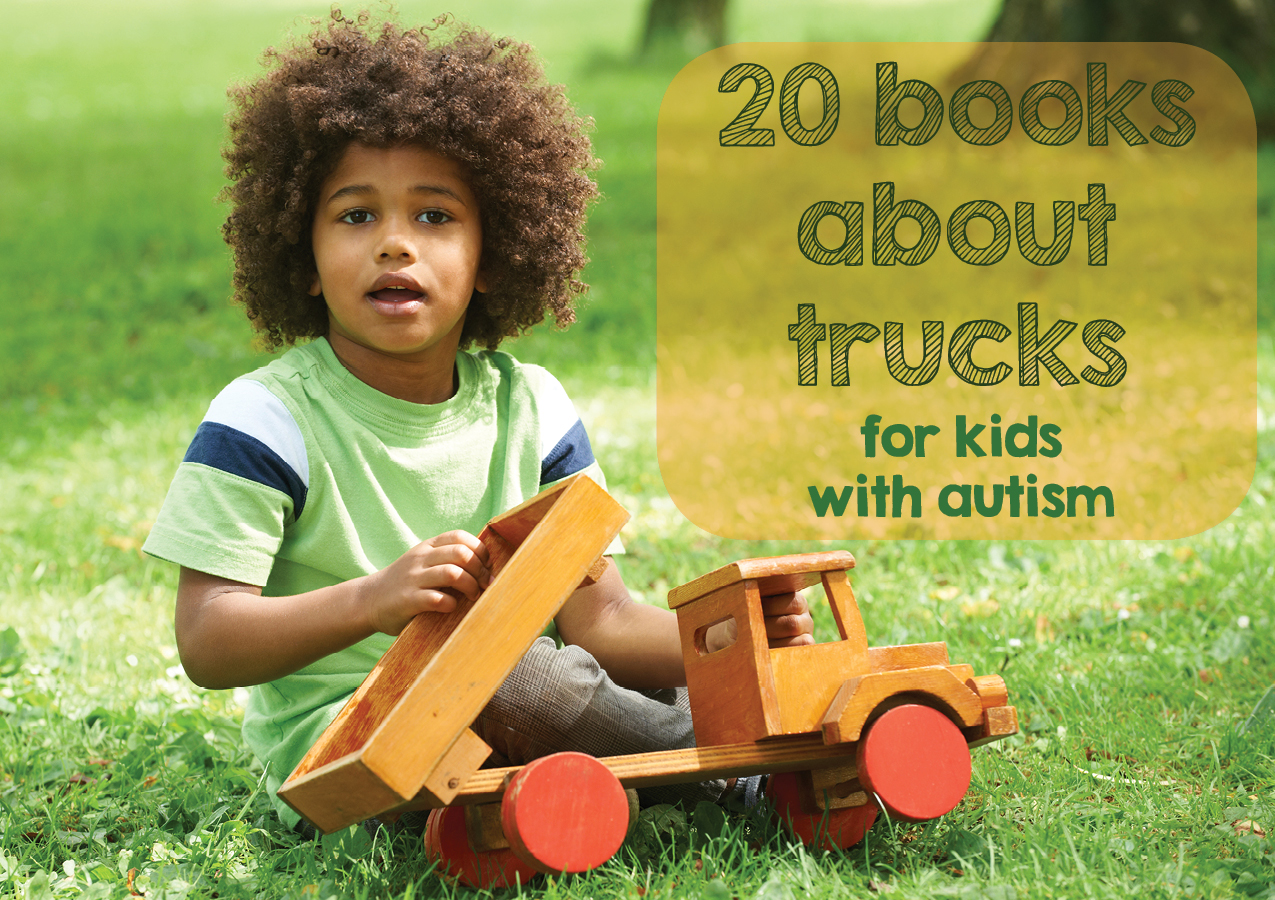
I remember scrutinizing the autism symptoms checklists in the months after my kids turned two. Somewhere on every one of those lists you would be sure to find turning over toy cars and trucks to spin their wheels (check!). I remember one list I came across explicitly warning of "obsessive" or "restricted" interests, and giving the example of fire trucks. I was incredulous. What could be wrong with really liking fire trucks?
What they do a terrible job communicating with these early childhood screening tools, is that so many autistic traits are quite wonderful! My son Luke's long-standing obsession with trucks (among other vehicles) has expanded his world tremendously. Trucks bring him joy, and they also help him connect with the world around him—including with books. Here are 20 of our favorite truck titles.
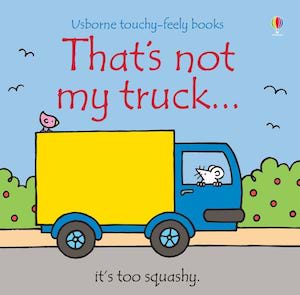
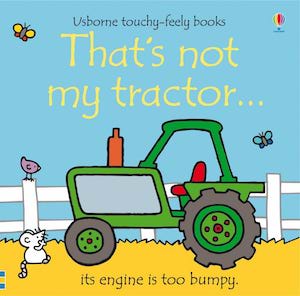
Usborne (2009, 2011); board book, $13.50
That's Not My Truck was one of the first books that my son Luke was able to really attend to at around age 2.5.
Pairing sensory play with books is an ideal way to develop an interest in books for all kids, not just autistic children, which is why there are so many sensory toddler board books. But I like the quality of the 'That's Not My...' series better than most.
First, there's a focus on sensory language. Starting with the cover, each turn of the page reveals a new texture and a word describing it. For That's Not My Truck! we discover 'bumpy,' 'shiny,' 'rough,' 'lumpy,' and 'ridgy'; and for That's Not My Tractor! we have 'bumpy,' 'rough,' 'smooth,' 'squashy,' 'scratchy,' and 'shiny.' You may be surprised at how quickly a language-delayed child can pick up 'soft' (at least receptively), if given a tactile, structured way to repeatedly access its meaning.
The series also builds vocabulary by introducing the words for types of the main subject or parts of its whole. When you read, "That's not my tractor. It's trailer is too rough," the tactile element (sandpaper) covers the trailer and nothing else, which really reinforces the new vocabulary word in a multi-sensory way. The visuals are also extremely well done. Cartoon images are simply drawn against solid backgrounds.
Here's a read-through video of That's Not My Tractor by YouTube user My Little Bunny.
Usborne's 'That's Not My...' books use very few words in a repetitive format, and that format is exactly the same throughout the (expansive series). Durable and adorable, these are must-haves for sensory-seeking little ones who need a nudge towards books.
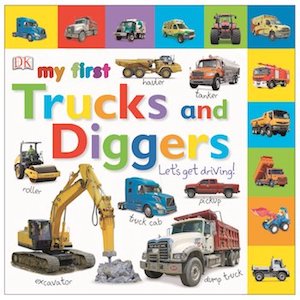
DK Publishing (2013); board book, $9.99
There are literally hundreds of different truck-themed titles in the photo concept board book market. Of all the publishing houses that churn these out, I tend to prefer ones by The DK Publishing, which display high quality pictures on empty white backgrounds that don't overstimulate.
My First Trucks and Diggers is a sturdy, tabbed board book with 13 spreads of clear photography and labels. Each tabbed spread has a different category of trucks. The categories don't make perfect sense (How is 'Jobs to Do' different than 'Emergency' or 'On the Farm') but it still works.
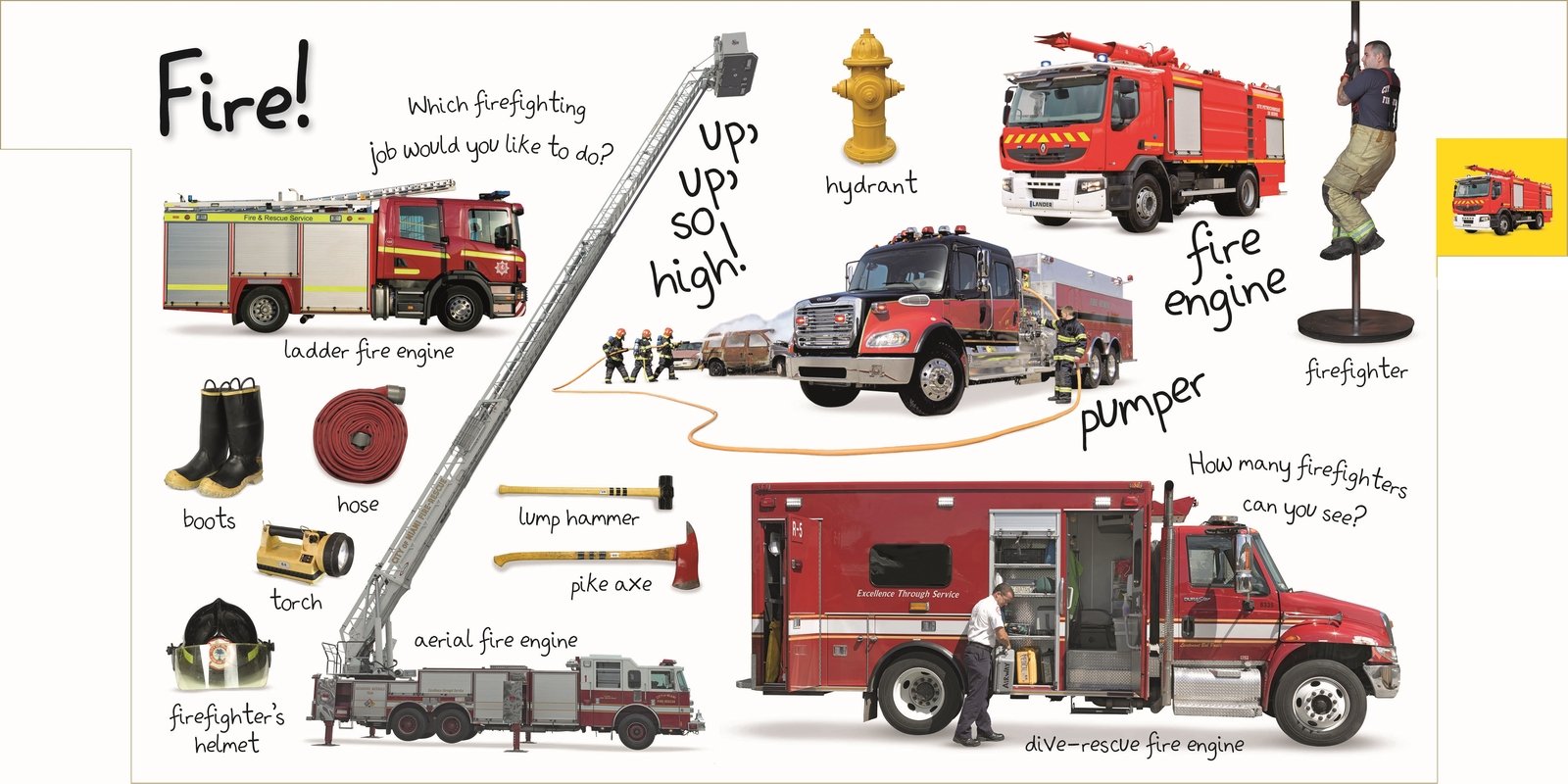
The font is a little too curly for my taste. And there are some prompts for parent-child interaction that strike me as overly aspirational for even a neurotypical toddler (ex. "Which firefighting job would you like to do?"). All kids develop differently and YMMV, but I find these tacting books to be most useful for developing an interest in solitary reading, not social reading, so the text wasn't something my sons engaged with (at least with me).
For my money, the most important social skill these books help to develop is pointing, and to the extent that I read this book with my sons, that's what I used it for. Having a bunch of books like this one that tie into your child's specific interests goes a long way with pointing practice!
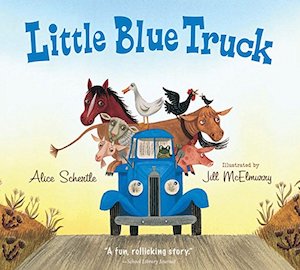
HMH Books for Young Readers (2008); hardcover, $17.99
This is extremely well-written poetry, and you can feel the beat as you read in a way that is predictive and helps kids anchor themselves in the words.
The use of animal and truck sounds also provides for lots of interactive opportunities. When I read this book, I stop to let Harry or Luke fill-in the animal or truck names or noises in turn. Animal noises are easier sounds to make than fully formed words, so for low-verbal children (like my son Luke), this is a way to practice intraverbals without placing a huge demand.
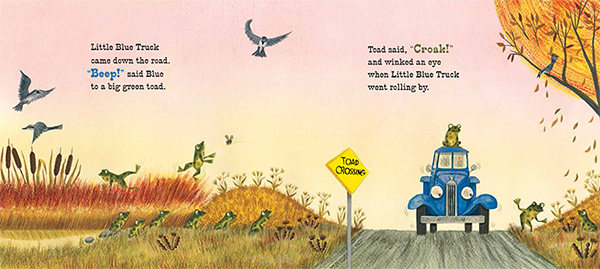
A favorite of autism and speech therapists everywhere for good reason—everyone should have a copy of Little Blue Truck!
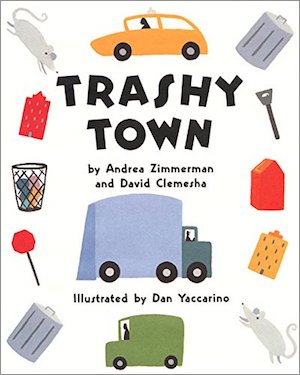
HarperCollins (1999); hardcover, $17.99
Mr. Gilly is a trash collector who works hard each day to clean up Trashy Town. He visits the school, the pizza parlor, the doctor's office, the park, and the fire station, and empties the trash cans into his truck; then he takes it all to the dump; and at the end of the day, he goes home for a well-earned bath.
With each collection stop, there is a repeated chorus, set in a rectangular, black sidebar on the right of each spread.
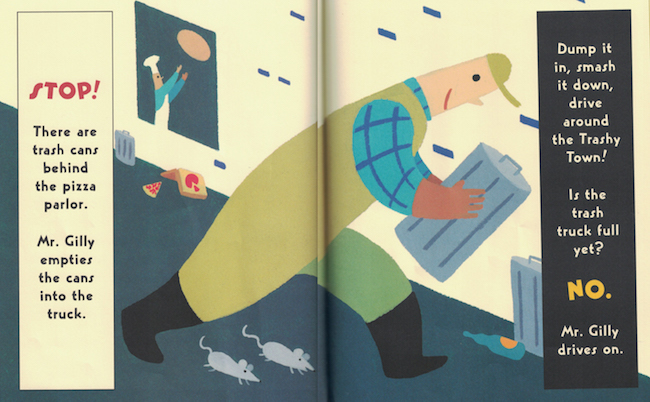
This book is perfect for kids with autism. My son Luke has asked for this book every night at bedtime for about three months running, and unlike most of his favorites, he enjoyed this one right out of the gate because there is a predictable, repetitive structure; there is rhythm; and (most critically) there are fill-ins that allow him to yell "NO!", which he finds endlessly fun.
It's unfortunate that Mr. Gilly is described in the book as a trashman, and not a trash collector or a sanitation worker (or something else both common and gender neutral). But these are very minor quibbles. Trashy Town is a truly marvelous book.
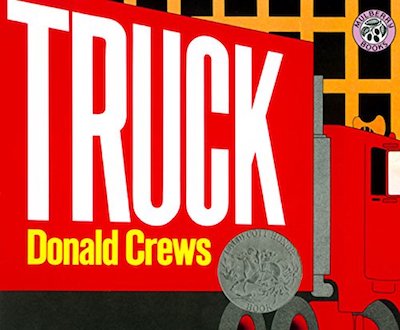
Greenwillow Books (1997); board book, $7.95
In this beloved Caldecott Honor book, we take off in a bright red semi-truck (loaded with bikes), with the bold white letters 'TRUCKING' printed on the trailer's side. We head out and go through a tunnel, visit a truck stop, drive through rain, muscle through a crowded highway, and make our way over a stacked interchange. In the end, we arrive at our destination and our cargo is unloaded.
We enjoyed Crews' Freight Train, which I reviewed awhile back in a round-up on train books, but my kids seem to enjoy Truck even more. It is visually exciting and there is an inherent story.
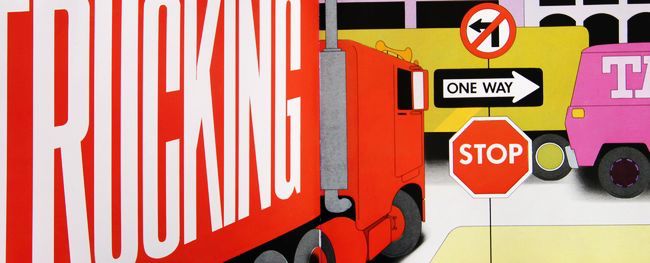
I love wordless picture books for kids with echolalia because it is more difficult to develop a script for a book without set text. Echolalia has been an issue for both of my sons, and any practice they can get reading without scripting is valuable.
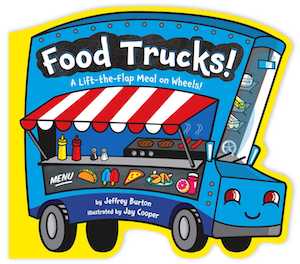
Little Simon (2016); board book, $7.99
Food trucks are a huge part of big city appetites. In New York, they are a reliable fixture of our streets, as plentiful as fire hydrants.
Since food can be such a big issue for autistic kids (both my kids have feeding therapy programs, so I know this firsthand), books that make food exciting can greatly increase the chance that one of my sons will try something new. I can't even imagine how convenient it would be for my family if my kids were interested in food trucks!
Food Trucks! aims to do exactly that, with a truck-shaped book that features flaps that reveal each truck's menu items and fixings. I dislike flaps for kids with fine motor issues who may get frustrated or tear the books, but these are fairly sturdy; and when fine motor delays aren't as much of an issue, interacting with a book in this way can help with interest.
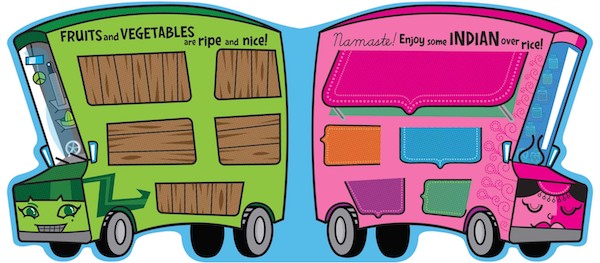
Wonderfully, the author chose to make each truck represent a different ethic cuisine. Beginning with the word "Hello!" in the appropriate language, we are introduced to new and exciting foods. So "Ciao!" introduces the Italian food truck, and we lift the flaps to discover pizza and spaghetti and "Ni hao!" precedes our introduction to lo mein and wontons. For health snobs, there's even a fruit and veggie truck. Food Trucks! is a lot of fun and does a great job of celebrating trucks, food, foreign languages, and a multicultural society.
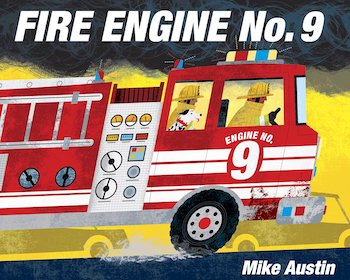
Random House Books for Young Readers (2015); hardcover, $16.99
Fire Engine No. 9 is an instant classic. The author-illustrator, Mike Austin, who is probably best known for Monsters Love Colors, is a master of vivid illustrations. Almost the entire story is told with sound words, providing children with a dramatic, sensory-based story telling experience. For low verbal kids, sounds are usually easier to manage, so encourage their participation! For children who are ready, you can use this as a pseudo-wordless picture book and practice the skill of telling a story.
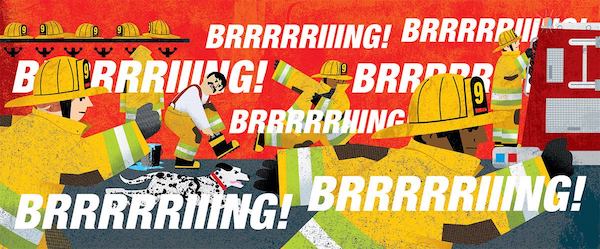
The plot is simple. "Fire at the corner of 4th and Main! Go, Engine No. 9, go!" the book begins, and the firefighters (who are diverse in skin color and include a woman) are off. An Italian restaurant is on fire, and the family who owns the restaurant lives above it and must be rescued. In the end, the family re-opens their restaurant as a mobile food van, and serves spaghetti to the firefighters to say thank you.
Many kids will enjoy the inside and back cover pages, which display items related to firefighting (gloves, flashlight, hose, nozzle, ax, etc.) with clear word labels. Parents will like that the final page after the story ends is "What to Do During a Home Fire" and illustrates how to "Get low and go!"
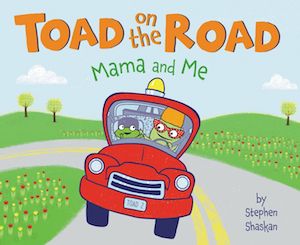
HarperCollings (2018), hardcover, $17.99
I reviewed this book only last month in my round-up of frog and toad books, but it needed to be on this list too.
Toad on the Road: Mama and Me is a strong sequel to Toad On the Road: A Cautionary Tale. A little toad is driving around with his Mama in her tow truck (on their way to a party, we will learn). On the way, they encounter a series of animals with different roadside emergencies.
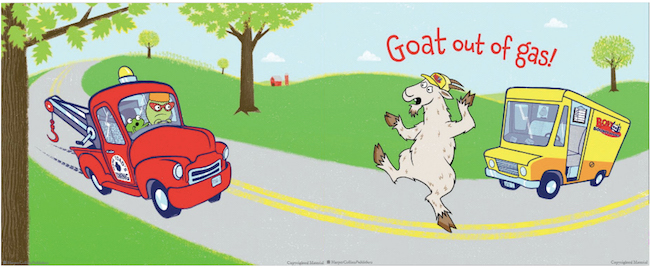
Each new animal, its vehicle, and the nature of the road emergency (out of gas, flat tire, stuck in the mud) is revealed via a silhouette in the distance. Kids can have fun trying to guess who and what's ahead. There is a super-catchy rhythm to this book and it's constructed with repetitive language and structure. The illustrations are bold, clean, and cartoon-like.
My son Luke can't get enough of the Toad on the Road series. I very much hope there will be more titles.
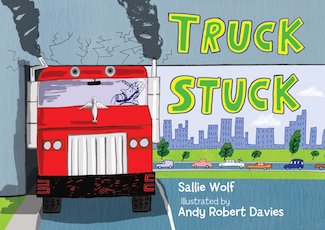
Charlesbridge (2008); hardcover, $14.95
A big red truck gets stuck trying to go under a viaduct that is too low. Soon there is a huge traffic jam! Simple rhyming text introduces a long line of inconvenienced vehicles and amused onlookers. Hijinks ensue as various people try and fail to unwedge the truck until one clever police officer has a bright idea in the end.
For truck fans, the appeal is obvious. There are innumerable trucks of different kinds, all whimsically illustrated. I'm a big fan of the exterminator's van with a giant bee bobbing on its roof. Each truck is labeled in the text's main font, but above each vehicle is a unique, hand-lettered noise-word that is drawn to help bring it to life.
The text itself has a steady, simple beat and rhyme scheme that makes it easy for kids to feel the words and follow along, ex: "Girl on Bike. Boy on trike. / Balloon parade. Lemonade."
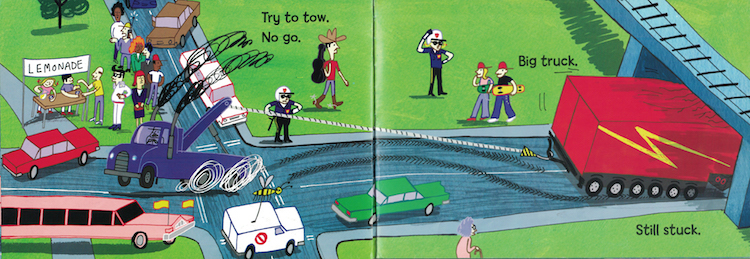
There are all sorts of great characters walking the pages of this book. I love the Boy Scout troop that marches through, the kids who capitalize on the moment and sell lemonade, and the Elvis impersonator and cowboy who decide to jam.
The resolution of the plot is a little weak and hard to understand for kids (the cop lets the air out and the truck lowers), but I find that the important thing is that the truck was stuck. 'Stuck,' it seems, is always funny.
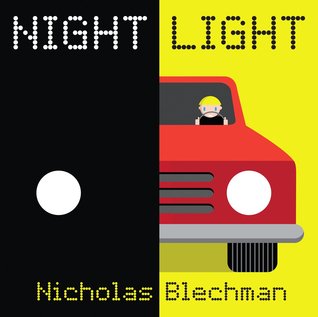
Orchard Books (2013); hardcover, $16.99
Night Light is a visually stunning counting and can-you-guess book. It uses die cuts to give kids a peek at the number of lights on the vehicle that will be revealed when the page is turned. I reviewed it last year in my blog post about counting books and it remains a favorite.

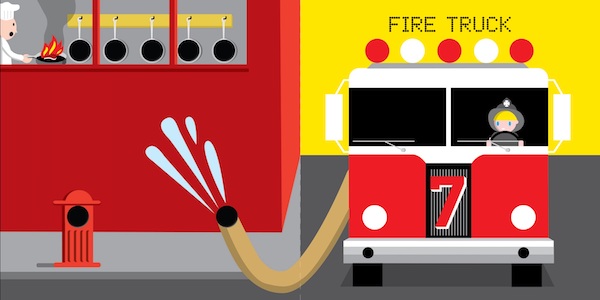
About half the vehicles in this book are trucks. There is a train, a helicopter, a loader, a taxi, a school bus, a fire truck, a snow plow, a tugboat, a street sweeper, and a tanker truck. In the end, the vehicles are revealed to be toys scattered on the floor of a child's room. The child is reading Night Light in bed, just like we are.
Night Light is the whole package. So many of our kids are motivated by numbers and sensory details (like die cuts), and the can-you-guess structure is a built in, intuitive way for parents to practice dialoguing during a read-aloud.
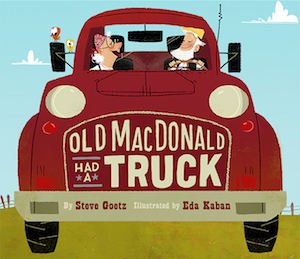
Chronicle Books (2016); hardcover, $16.99
Singalong books provide a multi-sensory reading experience that promotes attention, engagement, and enjoyment. Old MacDonald Had a Truck is a fun adaptation of the traditional tune. Old MacDonald, his wife, livestock, and other animals are running a machine-heavy farm. In the place of animals and animal sounds, as in the usual version, we are introduced to a variety of farm vehicles and their sounds and actions.
My son Luke found it very silly that the animals were workers on the farm, driving the vehicles. One thing that’s a bit different is that with every E-I-E-I-O, the 'O' sound is part of a sound or action word that the vehicle makes. On the page with the bulldozer, we read, “E-I-E-I- MOW”
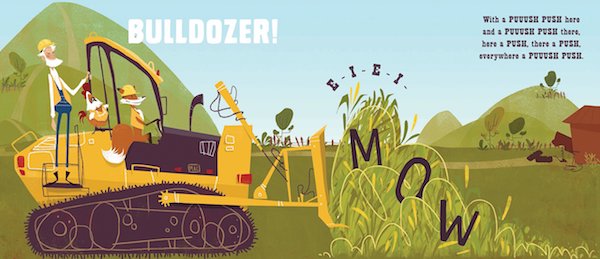
My kids enjoyed the graphic illustrations, but some may find them a little busy. If your child enjoys Old MacDonald Had a Truck you might also check out Goetz and Kaban's 2018 release, Old MacDonald Had a Boat.
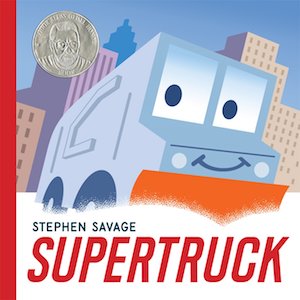
Roaring Brook Press (2015); hardcover, $12.99
A little grey garbage truck with thick Clark Kent-style glasses "just collects the trash" while all around him trucks do cool things like fix power lines (a green bucket truck), put out a fires (a red firetruck), or rescue others (a blue tow truck). But then there is a huge snowfall and the little garbage truck becomes 'SUPERTRUCK' and digs out the city!
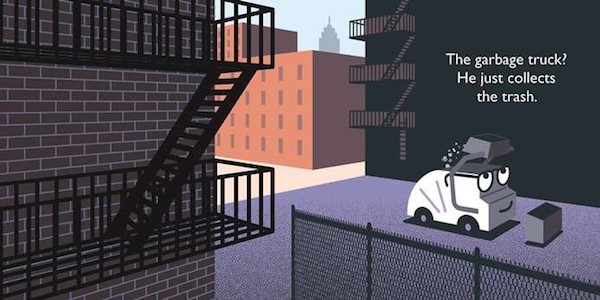
The art is wonderfully simple. The clean, digital illustrations set apart characters with distinct colors. Simple graphic line backgrounds show an urban setting without distracting. The transformation of the garbage truck from grey to blue is a perfect way to communicate the concept of a secret identity (although I wish he'd kept his glasses).
With just a short, single sentence on each two-page spread, Supertruck is an easy-to-understand superhero story for kids who love trucks.
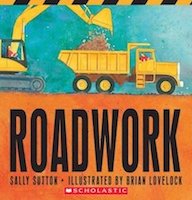
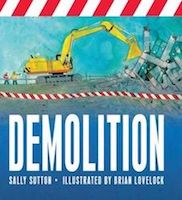
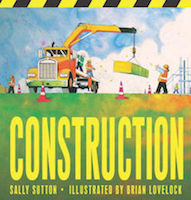
Candlewick Press (2008/2012/2014); hardcover ($15.99/$15.99/$16.99)
Roadwork, Construction, and Demolition are amazing books that will appeal to kids who love construction vehicles and watching, from start to finish, how workers use trucks and machines to transform a site or complete a project. Roadwork shows a new highway being dug, paved, wired, and painted. Construction is the story of a library being built. And in Demolition an old building is taken down so the land can be re-developed into a playground.
Sutton uses a driving, pulsing rhythm and rhyme scheme that communicates a lot of excitement. Each stanza ends with sound words that accurately convey, through onomatopoeia, the noise the machine makes. It’s extremely clear that author and illustrator have done a ton of research for each book, and children who read these will learn a lot about the nuts and bolts of construction.
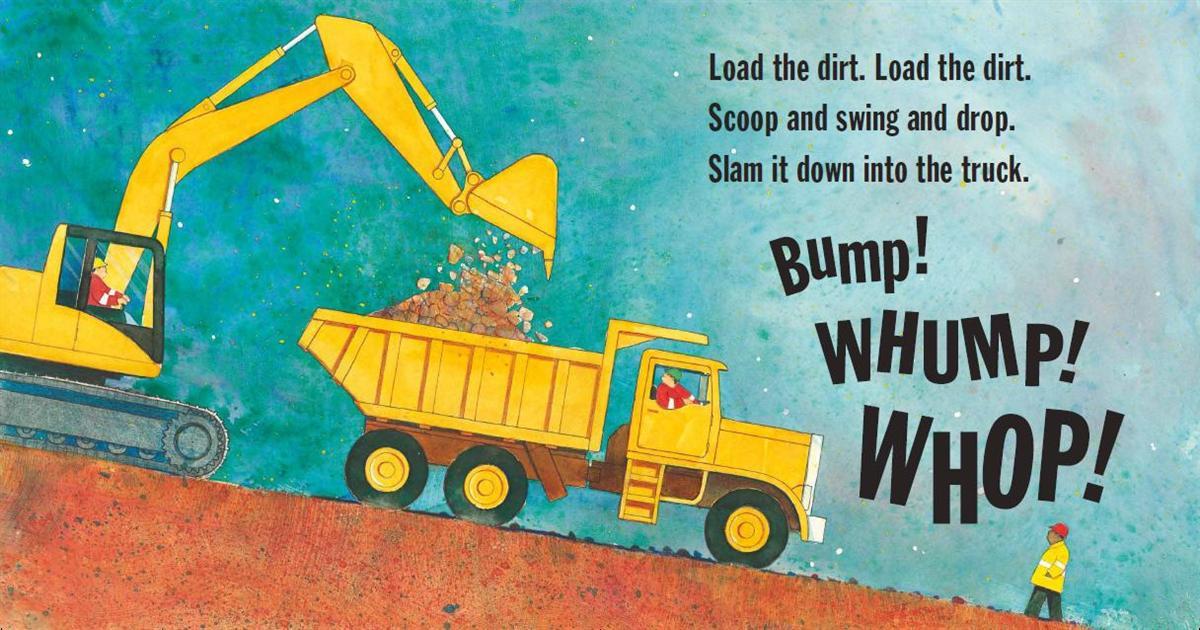
Lovelock’s illustrations in all three books are wonderfully diverse, both racially and in representation of women. Sutton’s story choices (building a playground, a library, and doing roadwork) are highly relevant to children, and that personal connection about how this work builds something that kids use is what makes this trio of books so special. A brilliant, well-executed series for construction vehicle lovers.
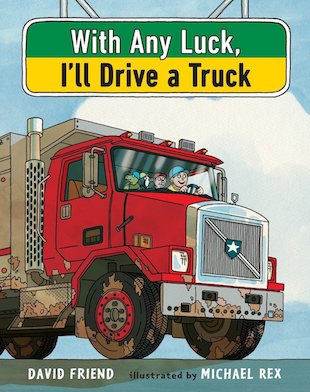
Nancy Paulsen Books (2016); hardcover, $16.99
Similar to the plot of Night Light, this is a book about a child imagining that his toy trucks are real (but with an actual story).
The boy tells us how at age 2 he learned to drive a concrete mixer, how at 3 he operated a backhoe, and how by 4 he was driving a firetruck, and so on. With each spread we see the boy, slightly older, alongside his animal co-workers (eventually revealed to be his pet cat and stuffed animals), operating various trucks on the job. All the big favorites are in the mix, plus some more unusual vehicles (like an earthmover, a combine, and a baler).
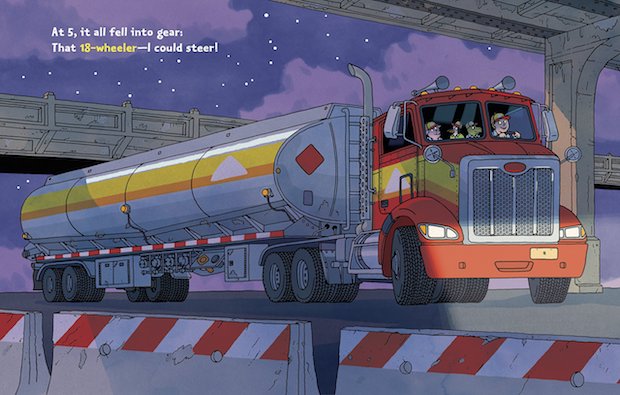
The text is written in a bouncy rhyme, making it easy for kids to follow along. I love how the truck names are printed in various colors so that they pop out and become sight words. I also love how the book weaves in the idea of age and getting older, which is a rarity outside of "birthday" genre books. Kids who like to tact numbers will enjoy this aspect too.
There is also a lovely moment of wish-fulfillment at the end, when we get a flash-forward to the boy, all grown-up, driving a truck on a highway with his childhood stuffies roped to the grill. I can't tell you how much I appreciate the sentiment of this—the celebration of a blue collar job as something to aspire to is far too rare. With Any Luck, I'll Drive a Truck celebrates having a strong interest and shaping a happy life around it.
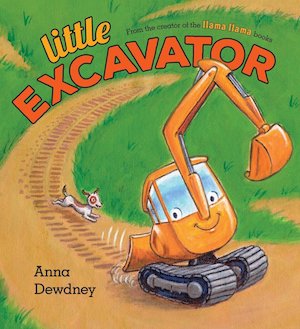
Viking Books for Young Readers (2017); hardcover, $17.99
I wrote a goodbye letter to Anna Dewdney on this blog on the sad occasion of her untimely passing in 2016. Best known for her Llama Llama series, she has been an important author for my son Luke, in particular. Her books feature characters who are easy for kids to identify with. They are usually grappling with social-emotional issues or brand new social situations. Dewdney had an incredible gift for verse and for telling simple stories with emotional richness.
Little Excavator, published posthumously, is another very special book. It tells the story of Little E, a young and small excavator who is trying to be as useful as the rest of the crew he's working with who are all grown-up, heavy construction trucks.
Dewdney's trademark lively poetry taps along, beginning each stanza by naming the big trucks in turn, along with their function. The word for each vehicle is shown in a color that matches the truck's paint job. The end of each stanza punches a trio of sound effects and action words, rife with onomatopoeia and a visual feeling of the words through font, color, and placement decisions that suggest movement.
On alternate pages, Little E tries to copy what the big trucks are doing, but he isn't built right for any of these tasks. In the end (of course), a job needs to be done that only a little excavator can manage. Little E learns that while he can't do everything others can do, there are things that make him special.
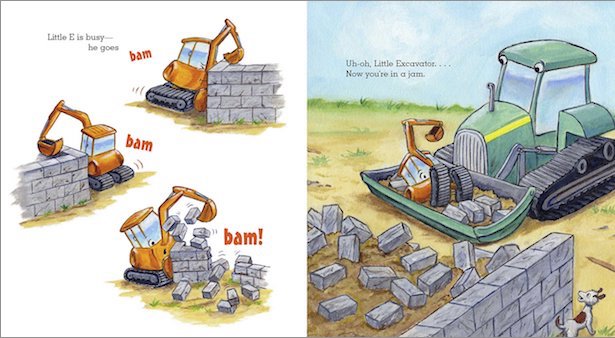
There is a broader message here about ability and differences in how our bodies work. While abstract for most, it's a message to grow into as understanding of the text deepens.
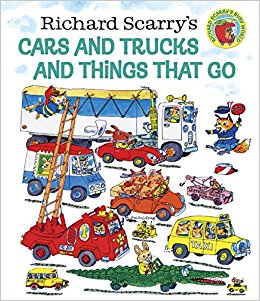
Golden Books (1951, first ed.); hardcover, $15.99
My kids have actually been interested in the classic Richard Scarry books for years. There is so much to look at! There are always a lot of vehicles and animals and there a lot of physical humor.
Because my son Harry is now reading, his interest in Cars and Trucks and Things That Go has increased. Sight words and short sentences are well-aided by simply drawn illustrations set against a plain white background.
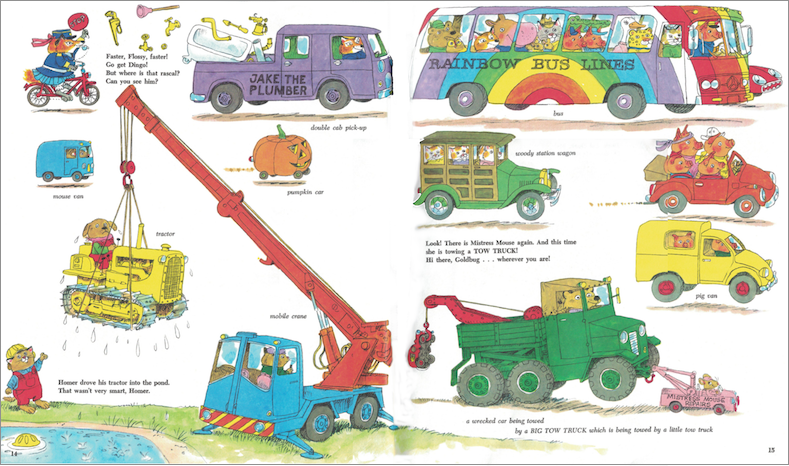
Kids familiar with Busytown will feel right at home in this exploration of the trucks and cars. We follow the story of Ma, Pa, Pickles, and Penny Pig as they set out for a picnic. The plot is thin and not really the point, but my son enjoys seeing what the Pig family is getting up to with each page turn.
Like other Richard Scarry titles, Cars and Trucks and Things that Go has been updated over the years to be less sexist. So even though this book was originally published in 1951, you can still hand it to your kids without too much concern.
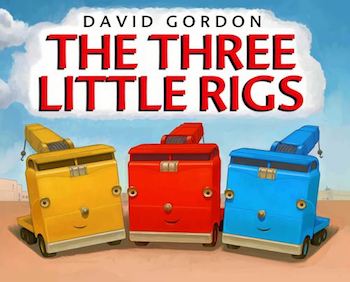
HarperCollins (2005); hardcover, $17.99
I’m always on the hunt for books that do fairy tales well. But until recently, I haven’t been willing to consider introducing books that “twist” the tale since my children still need to learn the original stories. I don’t want to confuse them, particularly because of how scripted and rigid they can be about text. This may sound a bit paranoid, but fairy tales are foundational to Western culture (and important to me).
Luke and Harry, however, now have The Three Little Pigs in their repertoire, thanks to the Nosy Crow fairy tale series (which I reviewed alongside their apps a few months back in my defense of screen time), so I decided to give The Three Little Rigs a try.
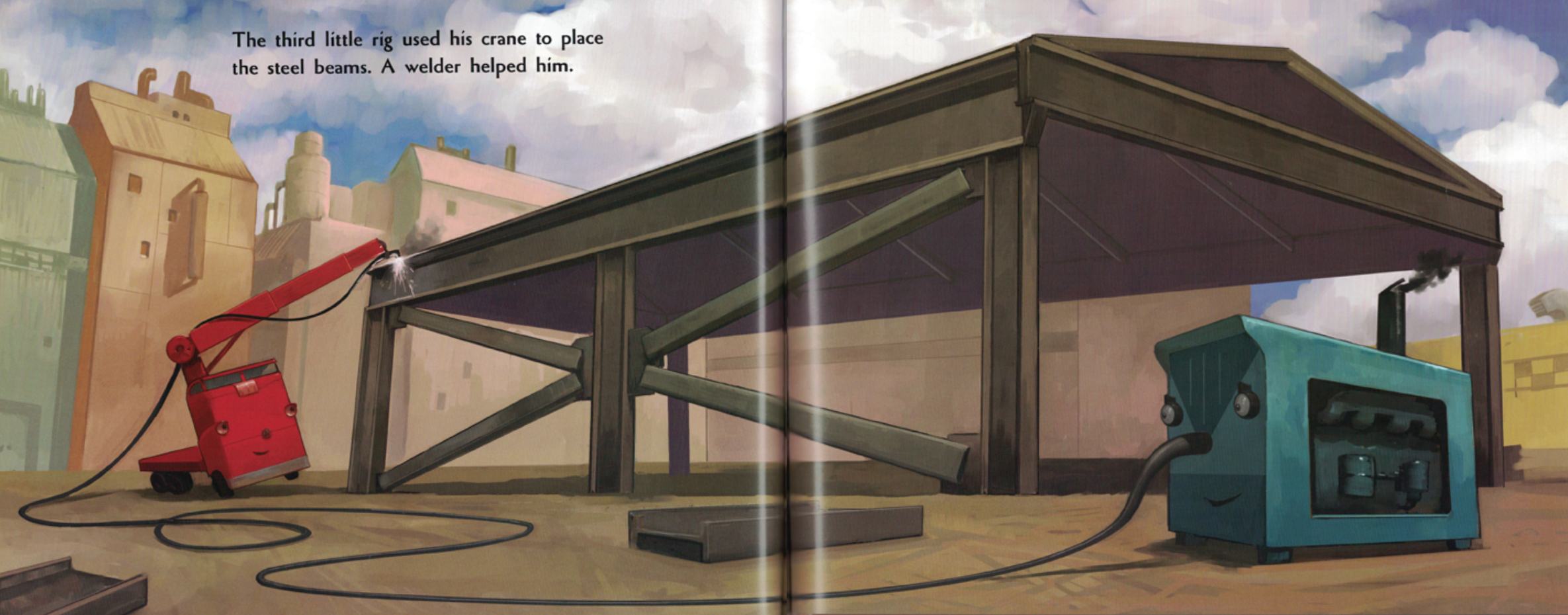
Despite the general darkness of the illustrations, my boys immediately understood this was a version of The Three Little Pigs, but with trucks, and were interested.
But Luke’s attention waned when he realized that the story had a lot of differences. It’s not just that the pigs are trucks or that the Big Bad Wrecking Ball has taken the place of the Big Bad Wolf. There are also helper characters that assist each truck to build their home, and the Big Bad Wrecking Ball has two other demolition-related machines that help it to destroy the trucks’ garages.
But I think the change that discouraged Luke the most was that the second garage was made of brick, and it was destroyed! (The final garage is made of steel.) Luke particularly likes to say, “But the brick house DIDN’T fall down!” so this really ruined things for him.
Harry, on the other hand, was mesmerized to be introduced to a new version of the “Three Little Pigs,” and requested the book repeatedly for days. His familiarity with the original story was extremely motivating, and he fully enjoyed the macabre ending in which the Big Bad Wrecking Ball and his friends are melted.